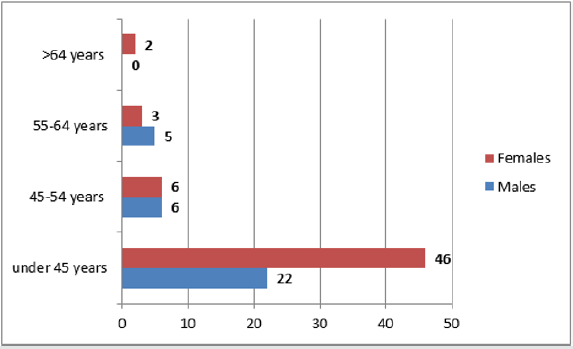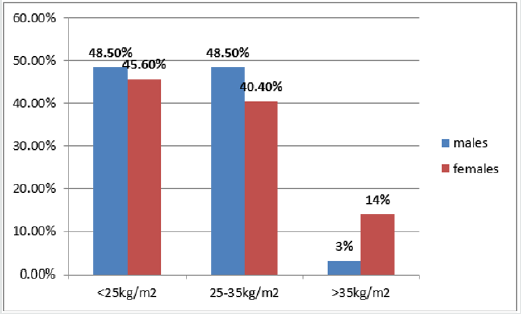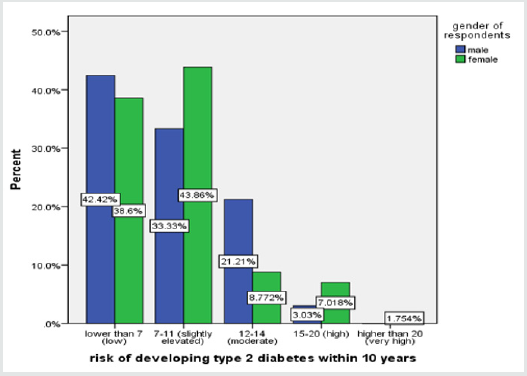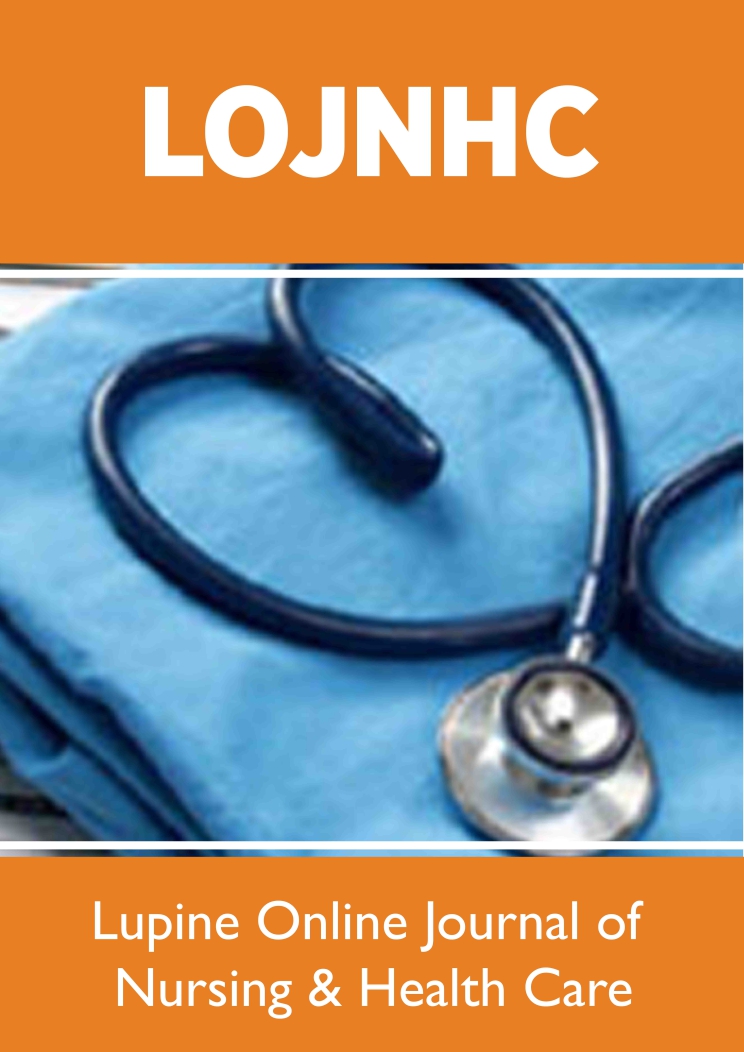
Lupine Publishers Group
Lupine Publishers
Menu
ISSN: 2637-6695
Research Article(ISSN: 2637-6695) 
Risk Assessment of Type 2 Diabetes Among Population of Rawalpindi Pakistan Volume 3 - Issue 1
Rizwana Shahid*, Syed Arshad Sabir, Sana Bilal, Sheikh Abdul Rehman, Mahjabeen Qureshi and Sidra Nasim
- Assistant Professor Community Medicine, Pakistan.
Received: May 06, 2020; Published: May 20, 2020
Corresponding author: Rizwana Shahid, Assistant Professor Community Medicine, Pakistan.
DOI: 10.32474/LOJNHC.2020.03.000151
Abstract
Objective: To determine the risk for developing type 2 diabetes among population of Rawalpindi city.
Subjects & Methods: A cross-sectional descriptive study was conducted among 90 healthy attendants of the patients admitted in wards of Holy Family Hospital, Rawalpindi to assess their risk for developing type 2 diabetes. Data was gathered through consecutive sampling. All study participants knew they did not have any type of diabetes and they were not receiving anti-diabetic drugs. The data was collected during 2 weeks in July 2018 by means of structured questionnaire. The data was analyzed by using SPSS version 25.0
Results: Of the total 90 study subjects, 57 were females. Mean age of respondents was 44.6±5.78 years. About 10% respondents had Body Mass Index (BMI) greater than 35kg/m2 and had very high risk of developing type 2 diabetes within next 10 years. Daily consumption of fruits and vegetables seemed to have statistically insignificant relationship (P>0.20) with reduction in risk for type 2 diabetes. Only 01 respondent out of those physically active at work was at high risk for type 2 diabetes. About 27.8% respondents had positive family history. Risk of developing type 2 diabetes was insignificantly associated with gender (P>0.94). Overall, only 6 respondents predominantly females 55-64 years old had high to very high risk of developing type 2 diabetes.
Conclusion: Majority of the study participants had low to slightly elevated risk of developing type 2 diabetes. This risk can better be eliminated by lifestyle modification.
Keywords: Type 2 Diabetes; Risk Assessment; Body Mass Index; Family History
Introduction
Type 2 Diabetes is a chronic metabolic disorder showing
enormously raised prevalence worldwide. Number of people
affected by this epidemic is expected to double in next decade [1].
This disease is incurable. However, various treatment modalities
endorsed are lifestyle modifications, reducing obesity, intake of oral
hypoglycemic drugs and insulin sensitizers [1]. Type 2 Diabetes is
among the greatest public health threats associated with drastic
escalation of its incidence globally [2]. Type 2 Diabetes ought to
investigate in overweight adults of any age with history of one or
more risk factors [3]. This disease is attributed to amalgamation
of numerous environmental and genetic risk factors [3]. However,
investigation of type 2 diabetes should commence at age of 45
among people not having relevant risk factors [4].
Type 2 diabetes is found to be prevalent in certain races like
African Americans, Hispanics and Native Americans who are
more susceptible to diabetes than Caucasians [5] Even victims are
unaware of their disease due to mildness of associated symptoms
[5]. WHO has regarded population of developing countries as more
prone to develop type 2 diabetes [6]? According to International
Diabetes Federation Report 2015, 415 million people are suffering
from this disease globally and about 642 million people are
expected to be victimized by 20406. Proportion of diabetics is
likely to double in near future primarily due to increased life
expectancy and urbanization irrespective of the prevalence of
obesity [7]. However, there is likelihood to arrest this increase by
lifestyle modifications [8]. A systematic analytical study carried
out among Pakistani population in 2015 showed 11.8% people with type 2 diabetes and situation was expected to be grave with
passage of time [9]. The present study is intended to assess the risk
factors for type 2 diabetes among Pakistani population specifically
of Rawalpindi city to identify the risk factors for this disease. This
research will provide useful information to our policy makers for
strategic planning in this concern.
Subjects and Methods
A cross-sectional descriptive study was carried out among healthy attendants of the patients admitted in wards of Holy Family Hospital, Rawalpindi to determine their risk of developing type 2 diabetes. Information was gathered from 90 attendants not suffering from type 2 diabetes through consecutive sampling during two weeks in July 2018. Confirmed diagnosed cases of type-II diabetes were excluded from this study. The information was collected from study participants by using Type 2 diabetes risk assessment form designed by Prof. Jaakko, Department of Public Health, University of Helsinki. Data was collected from study participants pertinent to their demographic profile, BMI, waist circumference, physical activity, dietary habits, family history and relevant health profile. Waist circumference was measured by means of inch tape and weight was measured by weight machine. Data was analyzed by using SPSS version 25.0. Frequency and percentage were calculated for all variables. Gender based risk of type 2 diabetes was statistically confirmed by applying Fisher’s Exact test. Statistical association of type 2 diabetes risk with regular consumption of fruits and vegetables was verified by chi-square test. P-value≤0.05 was taken as significant.
Results
Majority of study participants (63.33%) were females. Mean age of respondents was 44.6±5.78 years. Most of the males (48.5%) were observed to have waist circumference less than 94cm while majority of female respondents (43.9%) had 80-88cm waist circumference. About 75.6% study subjects were under 45 years of age and only 2.2% respondents were above 64 years old. Age based gender distribution of the study subjects is shown in Figure 1. Fruits, vegetables, and berries were consumed every day by 44.4% of study subjects. Moreover, daily consumption of fruits and vegetables revealed statistically non-significant relationship (P>0.20) with reduction in risk of type 2 diabetes. Most of the females in comparison with males had BMI greater than 35kg/ m2 as depicted below in Figure 2. Out of 9 respondents with BMI>35kg/m2 only 3 were determined to be at high to very high risk (Risk score 15-20) of developing type 2 diabetes. Out of 90 study participants, 31.6% females had waist circumference more than 88cm while only 18.2% males had waist circumference more than 102cm. About 42% of females and 67% of males were found to have 30 minutes of daily physical activity at work. Only 1 study subject out of those engaged in daily physical activity at work was found to be at high risk of developing type 2 diabetes within 10 years as depicted below in Table 1. Only 16.7% respondents were taking medication for hypertension regularly while only 12.2% participants gave history of hyperglycemia during their lifetime out of which 54.5% were males. According to type 2 diabetes risk assessment scale designed by Prof. Jaakko, risk of developing type 2 diabetes within next 10 years among study subjects is illustrated below in Figure 3. However, risk of developing type 2 diabetes was found to be insignificantly associated with gender as depicted below in Table 2. 27.8% respondents had their immediate family members suffering from type 2 diabetes while 37.8% subjects had no relevant family history.
Discussion
The prevalence of diabetes mellitus is estimated to rise from 2.8% in 2000 to 4.4% in 2030. This means that about 366 million world population will be diabetic by the end of next 10 years [10]. This prevalence is more likely to grow exponentially in third world countries [11]. In response to the current scenario, implementation of primordial preventive measures to control this modern epidemic is the need of time. In present study, low risk of developing type 2 diabetes within next 10 years was found among 36 (40%) study subjects whereas high to very high risk was found among only 6 (7%) respondents out of which 5 were females. Another Asian study carried out in 2016 on 150 urban slum developers using Finnish Diabetes risk score showed 11.3% people at high to very high risk of developing type 2 diabetes within next 10 years [12]. The reason for low risk in current study might be inadequate sample size (90). Real picture could better be achieved by conduction of research on more individuals. The current study showed high risk (1%) of developing type 2 diabetes among 5% of study subjects found to be physically inactive and were taking medication for high blood pressure. Similarly, an Indian study showed about 11% risk of developing type 2 diabetes among 53.3% study subjects found to be physically inactive [12]. Both research showed proportionate relationship of lack of physical activity/exercise with risk of developing type 2 diabetes. Although social and print media is playing marvelous role in getting our people aware of diverse physical activities in accordance with their circumstances and workplace but apart from physical fitness people should also be sensitized specifically for their wellbeing. This study concluded high to very high risk of developing type 2 diabetes among 7% respondents with their positive family history, while a study by [13] among population of Bangladesh revealed 47.7% of participants with positive family history [13]. A similar Brazilian research carried out in 2013 reflected that 47% of respondents had positive family history of type 2 diabetes [14]. Contrary to international research, current study is depicting raised percentage of positive family history among Pakistani population. This factor can better be scrutinized by conduction of research on large number of individuals.
About 14% female study subjects in current study had BMI>35kg/m2. Another research revealed higher risk of type 2 diabetes among females due to greater tendency of putting weight among them. This feature is significantly attributed to variations in sex hormones in addition to genetics, familial tendency, and lifestyle [15]. There is need to do rigorous research on this aspect across countries by eliminating confounders to determine scientific association of obesity with hormones. According to our study, 5 females out of 6 were determined to be at high to very high risk of developing diabetes. Contrary to these results, an international study concluded the high risk for type 2 diabetes among males [16]. The reason for this variation might be the racial difference and social set up. However, these factors need in depth insight to reach the accurate conclusion. The present study revealed that consumption of fruits and vegetables is insignificantly associated with protection from risk of developing type 2 diabetes (P>0.20). Likewise, a study by [17] portrayed insignificant association (P>0.20) in this regard [17]. This aspect entails detailed elaboration of associated factors like intake of fatty foods and protein diet apart from consumption of fruits and vegetables. Our results showed that only 15 respondents were regularly taking medication for high blood pressure out of which 5 subjects were at high risk of developing type 2 diabetes within next 10 years. On the other hand, a prospective study carried out among hospitalized patients of Bulgaria revealed higher risk for developing type 2 diabetes among hypertensive patients [18]. As current study is cross-sectional descriptive and carried out among non-diabetics, this might be the reason for less individuals at high risk for developing type 2 diabetes within next 10 years.
Conclusion and Recommendation
High risk of developing type 2 diabetes was found among females 55-64 years of age with very high BMI, no physical activity and specifically with diabetic history of immediate family members. Considering study results, risk of developing type 2 diabetes in the community can be minimized by increased physical activity and weight reduction However, these study subjects should regularly be followed up for development of type 2 diabetes.
References
- Olokoba AB, Obateru OA, Olokoba LB (2012) Type 2 Diabetes Mellitus: A review of current trends. Oman Med J 27(4): 269-273.
- Whiting DR, Guariguata L, Weil C, Shaw J (2011) IDF Diabetes atlas: Global estimates of the prevalence of diabetes for 2011 and 2030. Diabetes Res ClinPract 94(3): 311-321.
- Bi Y, Wang T, Xu M, Xu Y, Li M, et al. (2012) Advanced research on risk factors of type 2 diabetes. Diabetes Metab Res Rev 28: 32-39.
- American Diabetes Association (2017) Standards of Medical Care in Diabetes. Diabetes Care 36(1): 11-66.
- Begic E, Arnoutovic A, Masic I (2016) Assessment of Risk factors for Diabetes Mellitus type 2. Mater Sociomed 28(3): 187-190.
- IDF-Diabetes Atlas. (7th). [Online] [cited 2016 May 3].
- (2006) Diabetes Prevention Program Research Group: Reduction in the incidence of type 2 diabetes with lifestyle intervention or metformin. N Engl J Med 346(6): 393-403.
- Tuomilehto J, Lindstrom J, Eriksson JG, Valle TT, Hamalainen H, et al. (2001) Prevention of type 2 diabetes mellitus by changes in lifestyle among subjects with impaired glucose tolerance. N Engl J Med 344(18): 1343-1350.
- Meo SA, Zia I, Bukhari IA, Arain SA (2016) Type 2 diabetes mellitus in Pakistan: Current prevalence and future forecast. J Pak Med Assoc 66(12): 1637-1642.
- Wild S, Roglic G, Green A, Sicree R, King H (2004) Global Prevalence of Diabetes: Estimates of the year 2000 and projections for 2030. Diabetes Care 27(5): 1047-1053.
- Wu Y, Ding Y, Tanaka Y, Zhang W (2014) Risk factors contributing to type 2 diabetes and recent advances in treatment and prevention. Int J Med Sci 11(11): 1185-1200.
- Dagdiya KR, Thakre SS, Thakre SB (2016) Assessment of risk of developing type 2 diabetes mellitus in urban slums of central India: A community based cross-sectional study. International Journal of Community Medicine and Public Health 3(11): 3241-3245.
- Saquib N, Khanam MA, Saquib J, Anand S, Chertow GM, et al. (2013) High Prevalence of type 2 diabetes among urban middle class in Bangladesh. BMC Public Health 13(1): 1-9.
- Marinho NBP, De Vasconcelos HCA, Alencar AMPG, De Almeida PC, Damasceno MMC (2013) Risk for type 2 diabetes mellitus and associated factors. ActaPaulista de Enfermagem 26(6): 69-574.
- Kautzky Willer A, Harreiter J, Pacini G (2016) Sex and gender differences in risk, pathophysiology, and complications of developing type 2 diabetes mellitus. Endocr Rev 37(3): 278-316.
- Schmid R, Vollenweider P, Waeber G, Marques Vidal P (2011) Estimating the risk of developing type 2 diabetes: A comparison of several risk scores; The Cohort Lausanniose study. Diabetes Care 34(8): 1863-1868.
- Chen L, Magliano DJ, Balkau B, Colagiuri S, Zimmet PZ, et al. (2010) AUSDRISK: An Australian type 2 diabetes risk assessment tool based on demographic, lifestyle, and simple anthropometric measures. Med J Aust 192(4): 197-202.
- Nikolova A, Milanova, Stoyanov K, Yankov G (2017) Risk Assessment for Diabetes Mellitus type 2 in women with hypertension. Journal of Hypertension 35(286).
Editorial Manager:
Email:

Top Editors
-

Mark E Smith
Bio chemistry
University of Texas Medical Branch, USA -

Lawrence A Presley
Department of Criminal Justice
Liberty University, USA -

Thomas W Miller
Department of Psychiatry
University of Kentucky, USA -

Gjumrakch Aliev
Department of Medicine
Gally International Biomedical Research & Consulting LLC, USA -

Christopher Bryant
Department of Urbanisation and Agricultural
Montreal university, USA -

Robert William Frare
Oral & Maxillofacial Pathology
New York University, USA -

Rudolph Modesto Navari
Gastroenterology and Hepatology
University of Alabama, UK -

Andrew Hague
Department of Medicine
Universities of Bradford, UK -

George Gregory Buttigieg
Maltese College of Obstetrics and Gynaecology, Europe -

Chen-Hsiung Yeh
Oncology
Circulogene Theranostics, England -
.png)
Emilio Bucio-Carrillo
Radiation Chemistry
National University of Mexico, USA -
.jpg)
Casey J Grenier
Analytical Chemistry
Wentworth Institute of Technology, USA -
Hany Atalah
Minimally Invasive Surgery
Mercer University school of Medicine, USA -

Abu-Hussein Muhamad
Pediatric Dentistry
University of Athens , Greece

The annual scholar awards from Lupine Publishers honor a selected number Read More...









